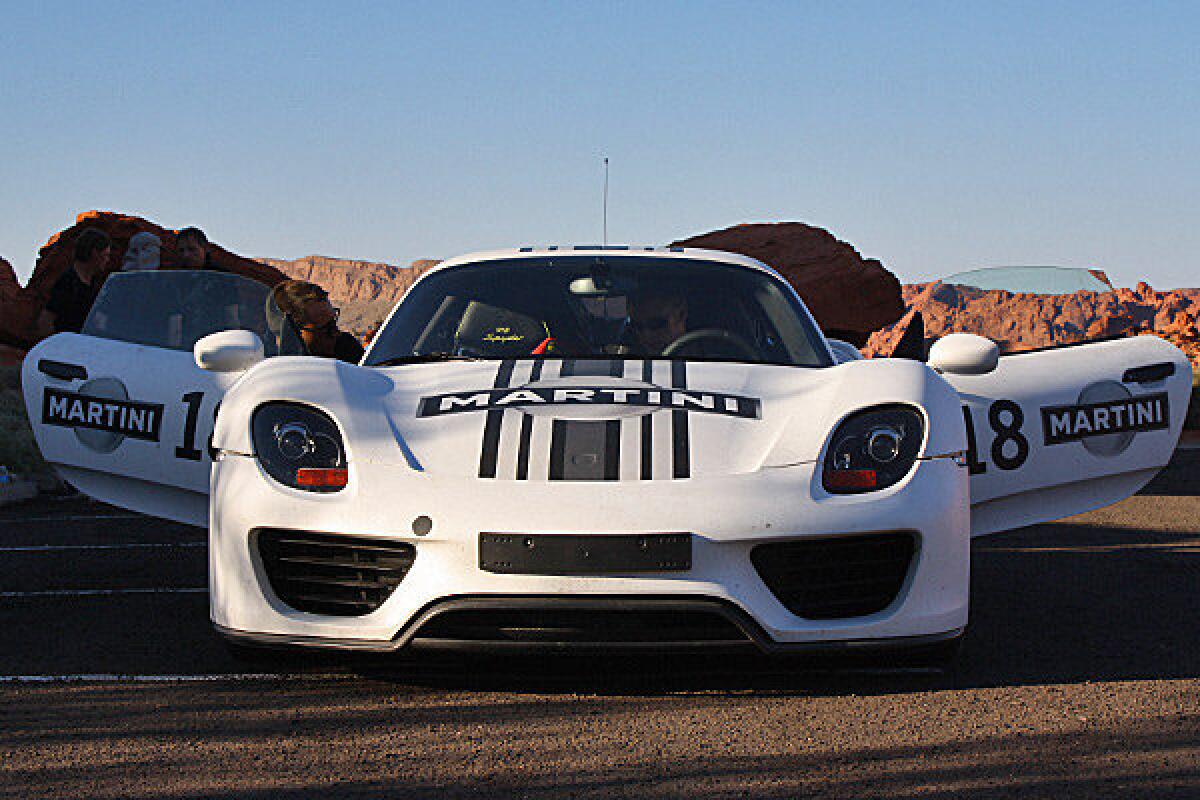First ride: Sitting shotgun in Porsche’s upcoming 918 Spyder supercar

- Share via
Several weeks ago, on a hot Monday afternoon in the Nevada desert some 50 miles northwest of Las Vegas, Porsche quietly gave a sneak peek at an all-new supercar project that will start production in a little less than a year’s time.
Past the freeway exit touting only a truck stop, a meandering road to nowhere and an eagle-eyed park ranger granting our group access to a gravel road, sat a parking lot containing two prototypes of Porsche’s future. They were resting after a day of hot-weather testing by several of the lead engineers on the project.
The car is dubbed the Porsche 918 Spyder. It’s a plug-in hybrid, capable of running on electric power only and it will be one of, if not the most, efficient cars in its class.
Photos: The details of Porsche’s 918 Spyder prototype
Lest you think Porsche has gone soft while it’s gone green, chew on these stats for a moment: the mid-engined 918 can do 0-60 mph in less than three seconds, hit 124 mph in 8.9 seconds and one of these prototypes recently lapped the famed 12.8-mile Nurburgring track in Germany in a scant 7 minutes, 14 seconds. To put that time into perspective, a production version of Porsche’s last supercar, the V-10 powered Carrera GT, did the same lap with the same driver in 7 minutes 28 seconds. That an unfinished test mule could find 14 seconds of time on that track means everyone should take this car seriously.
Porsche certainly does.
“There’s definitely a future in sports cars,” says Frank Walliser, chief engineer on the 918 project. “We believe in sports cars and we see using technology, especially in a very unique car like that, that pushes the borders of the technology.”
Walliser was keen to demonstrate what he meant, so we hop in one of the prototypes for a test ride. Porsche wouldn’t yet allow us to drive as handmade prototypes at this stage of testing cost many millions of dollars. (What will a production version of this car cost? A mere $845,000.)
The car starts up with nothing more than an electric whir; it’s always in full electric mode when you turn the key. Walliser flicks a large toggle switch to the right of the steering wheel to put the car into drive, and we glide silently and effortlessly out of the parking lot.
The first portion of our drive is in this E-mode; with a proper amount of battery, the car can travel up to 15 miles and up to around 95 mph on electric power only. At this point the car is powered by a pair of electric motors driving all four wheels with a total of 230 horsepower. One motor sits in the center of the front axle, while the other is situated between the engine and the gearbox.
This power is certainly enough to get the 3,750-pound car to move effectively and without strain, but it’s never overwhelming (consider that the Nissan Leaf weighs only 350 pounds less, yet has 113 fewer horsepower).
Once you’ve had your fill of electric power, a turn of the knurled aluminum knob on the steering wheel puts the car in Hybrid, the second of five drive modes. Here the car will operate on EV power when possible, but push your foot down hard and the 4.6-liter, 580-horsepower V-8 sitting behind you instantly jump to life. It’s a beautiful experience. One moment you’re cruising with the tranquil smoothness of electric power, the next you’re shoved toward the horizon with a hearty roar. Hybrid mode is an either-or experience; you’re powered by either the gas engine or the electric motors.
But wait, there’s more.
The next mode is Sport-Hybrid, and it and the subsequent two modes, Race-Hybrid and Hot-Lap keep the gas engine running at all times. It works to not only propel the car, but also keep the 6.8-kWh, liquid-cooled, lithium-ion battery pack in a constant state of charge. Each setting increases the amount of electric power that is added to the engine’s output.
Total output? A pants-kicking 795 horsepower and 575 pound-feet of torque. Handling all this power is a seven-speed, PDK (Porsche Doppelkupplung) dual-clutch transmission with paddle shifters. The V-8’s redline is a ridiculous 9,000 rpm, and the engine charges with impunity to that peak, kicking out a loud, smooth wail that anyone who’s spent time near a racetrack will appreciate.
Production 918s will have features found on other Porsches, including the company’s active suspension system (PASM) and torque vectoring. Though Walliser said the suspension on the prototype we rode in was close to the PASM’s Normal setting (drivers can also choose Sport), the ride quality was very firm. Here’s hoping this is one of the areas on the 918 that the company is still tweaking.
These suspension bits are bolted to a monocoque body shell made from carbon-fiber-reinforced plastic (CFRP), as are other body panels. Since this is indeed a Spyder, the two-piece CFRP roof is removable manually and stores in the trunk (at the front of the car) when not in use.
What’s clear, even from the passenger seat, is this is a stiff car with immense handling prowess. At one point during our drive as we cruised at about 60 miles an hour, Walliser jerks the wheel back and forth several times in a near-violent fashion. His point was not to see what I had for lunch, but to demonstrate how difficult it is to unsettle the 918.
Stability is aided by the electrically assisted steering system, which utilizes a small degree of rear-wheel steering. At low speeds, the rear wheels turn in the opposite direction from those in the front, for better maneuverability, while they move in concert with the front wheels at high speeds. Porsche says this system can shave as much as 5 seconds off the 918’s Nurburgring time.
After running the car through its various drive modes, Walliser leaves it in Race-Hybrid and falls silent, letting the car do the talking. We spend the rest of our drive doing high-speed runs to let the 918 show off its legs, the raw sound of V-8 ricocheting through the cabin, and off the burning red sandstone rock formations dotting the landscape.
We then head back to the staging area. As if to remind us that this isn’t a production vehicle and gremlins still lie in wait, at one point the car unexpectedly loses power, and shudders to a stop at the side of the road. Walliser apologizes, calmly reboots the car’s systems (there are 80 different control units on the 918, linking all the systems together; the Carrera GT had two), and restarts the car after a quick wait.
Moments later, we pull back into the parking lot, and the present.
The nuances of this car are so varied and detailed, we compiled a gallery of the salient bits of the Porsche 918 Spyder. Click here to learn more about the car.
ALSO:
Jaguar, Land Rover, Tata? Tiny car coming to U.S.
Cadillac confirms ELR plug-in hybrid
4-year-old uncovers Lexus trunk latch defect




